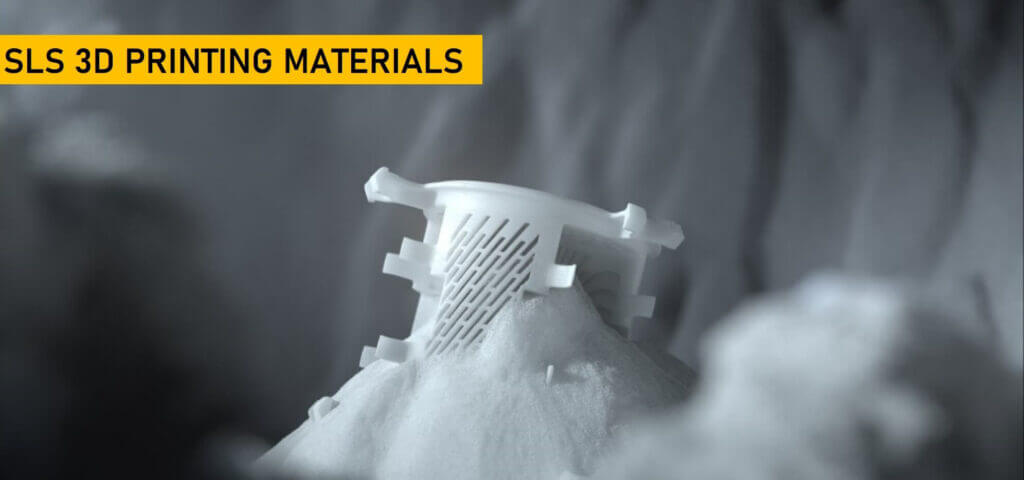3D printing technologies differ from each other in many categories including materials or filaments. Selective Laser Sintering (SLS), unlike other widely used 3D printing technology, produces product prototypes and end parts by sintering thermoplastic powder.
An SLS printer forms solid parts by sintering and fusing thermoplastic powder using a high-power laser. The thermoplastic powder makes SLS 3D printing technology effective in producing parts with higher toughness, impact strength, and dimensional accuracy.
Also, they speed up the additive manufacturing process by requiring no support structure. While planning an additive manufacturing project, you have the option to choose from a wide range of SLS 3D printers. The conventional SLS 3D printers support a single or specific material.
But the new-generation SLS 3D printers allow you to use and mix multiple materials. Based on your choice of a 3D printer, you have the option to choose from a wide range of materials for SLS 3D printing.
The materials used in SLS 3D printing differ from each other in many aspects, including tensile strength, heat deflection, and tensile modulation. You must keep in mind the nature and requirements of the part to be printed while comparing SLS 3D printing materials.
However, it is also important to compare the characteristics of each SLS 3D printing filaments. We are making it easier for you to choose the right SLS 3D printing materials for your next project by comparing their key characteristics.
Different Types of SLS 3D Printing Materials
The materials or filaments used in SLS 3D printing can be divided into three broad categories – general-purpose/unfilled, filled, and specialty. General-purpose 3D printing materials for SLS are unfilled nylon powder. They are often used for producing parts that do not require specific mechanical features.
At the same time, filled SLS 3D printing materials are produced by filling nylon with mineral fiber, glass additives, aluminum, or carbon fiber. The filling makes the nylon powder stiffer or more heat resistant. The specialty SLS 3D printing materials meet the requirements of parts with higher heat and chemical resistance properties.
Distinct Characteristics of Widely-Used SLS 3D Printing Materials
PA 11 Black (PA 850)
PA 850 is one of the most popular general-purpose nylon materials for SLS 3D printing. The mechanical properties of PA 11 Black deliver flexibility and ductility. Also, the material’s heat resistance and tensile strength remain intact throughout the 3D printing process. At the same time, its black color adds high contrast and low reflectivity to the 3D-printed part while keeping the grease, grime, and dirt hidden.
PA 12 White (PA 650)
Engineers opt for PA 650 as a general purpose SLS 3D printing material that delivers higher ductility. PA 650 is much stronger than other unfilled nylon filaments for SLS 3D printing. Also, it scores over PA 850 in the category of stiffness. PA 650 improves print quality by adding mechanical properties and chemical resistance.
PA 12 Black
PA 12 Black is one of the 3D printing materials with superior isotropic mechanical properties. The filament is produced by processing high tensile strength nylon. After the processing, the filament appears black through a dying procedure. Its ability to support smaller minimum feature resolutions makes PA 12 Black one of the preferred options for producing parts with intricate designs or more details.
PA12 Mineral-Filled (PA620-MF)
As the name suggests, this 3D printing material is produced by mixing nylon and mineral fiber. The mineral fiber constitutes 25% of the filament. The filling enhances PA 12’s strength, stiffness, and heat-resistance capacity drastically. Engineers opt for PA620-MF to produce parts that need to achieve maximum strength and higher temperature resistance.
PA12 40% Glass-Filled (PA614-GS)
This material is produced by filling PA 12 with 40% of the glass sphere. In addition to increasing PA 12’s stiffness and heat resistance, the glass sphere adds dimensional stability to the filament. But the glass additives reduce both impact and tensile strengths of the materials. Engineers opt for PA12 40% Glass-Filled (PA614-GS) while producing parts that need to resist wear and tear over a longer period of time.
Aluminum-Filled Nylon (Alumide)
This filled SLS 3D printing filament is produced by adding fine aluminum particles to polyamide powder. The aluminum particles increase the density of alumide. Also, they enhance alumide’s thermal and conductive properties. Engineers opt for aluminum-filled nylon while producing parts with a metallic appearance. Also, the material is best suited for producing mechanical parts that do not experience high stress.
Carbon-Fiber Filled Nylon (PA-FR)
PA-FR outperforms other 3D printing materials in the category of structural properties. The filament is produced by blending chopped carbon fiber with general-purpose nylon filaments. The blending makes the output stronger than other filaments. Also, engineers often opt for PA-FR due to its excellent electrostatically dissipative characteristics. In addition to being sturdy and lightweight, PA-FR is effective in resisting both wear and temperature.
TPU 70-A
This specialty material for 3D printing is used widely for producing items that can resist dynamic loads effectively and consistently. TPU 70-A differs from other SLS 3D printing filaments by combining impact resistance properties with a rubber-like elasticity. The soft and flexible material is currently used for producing grips, hoses, and gaskets with dynamic load resistance capability.
Polypropylene Natural
Polypropylene natural belongs to the category of specialty materials used in SLS 3D printing. In addition to being tough, durable, and flexible, this material is effective in resisting a wide variety of chemicals and acids. Engineers choose polypropylene natural while producing lightweight parts with the capability to resist most chemicals.
Conclusion
You can have the option to choose from a wide range of 3D printing materials for SLS 3D Printing according to the precise needs of a project. You can combine and use multiple materials by investing in a multi-material SLS 3D printer.
Similarly, you can experiment with different 3D printing materials by getting professional SLS 3D printing services. But you must remember that the materials for SLS 3D printing differ from each other in many categories.
Also, each of the materials has its pros and cons. Hence, you can improve the print quality only by differentiating SLS 3D printing materials based on their key characteristics.

